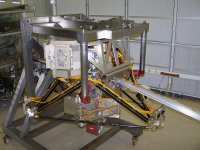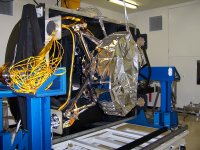MIRI ready for its cryogenic performance testing
6 December 2007
JWST's Mid-InfraRed Instrument (MIRI) is fully assembled in the cryo chamber at Rutherford Appelton Laboratory (RAL) UK, and ready for the first test of its functional and scientific performance under vaccum and cryogenic conditions, simulating the operational conditions in space.The instrument tested is a verification model of MIRI with flight-like components, including a set of detectors. The model is equipped with the flight software that will simulate telemetry to the ground and generate images from the test environment. The first milestone in this test campaign is expected to be reached already before Christmas, with the completion of a full functional test of the entire instrument.
MIRI is the first of JWST's four instruments to reach this phase of performance testing, marking a significant milestone for the MIRI European Consortium, which comprises more than 30 institutes and industries, and for its partners JPL and NASA in the USA.
MIRI is a combined infrared camera and spectrograph targeting the wavelength range between 5 and 28 μm and will study the early Universe and properties of materials forming around new-born stars in unprecedented detail. It will also be able to image directly massive planets orbiting other stars through its coronographic capabilities.
Future Milestones
Following the initial phase of testing there are further milestones for MIRI in 2008. Early in the new year there will be electromagnetic susceptibility testing. In spring 2008 further testing will take place using the MIRI Telescope Simulator (MTS). This simulator is unique to MIRI and simulates the optical characteristics of the JWST output beam. Simulated point sources can be placed anywhere in the MIRI field of view to allow thorough calibration of the instrument. The MTS will also provide line sources for spectral calibration.



